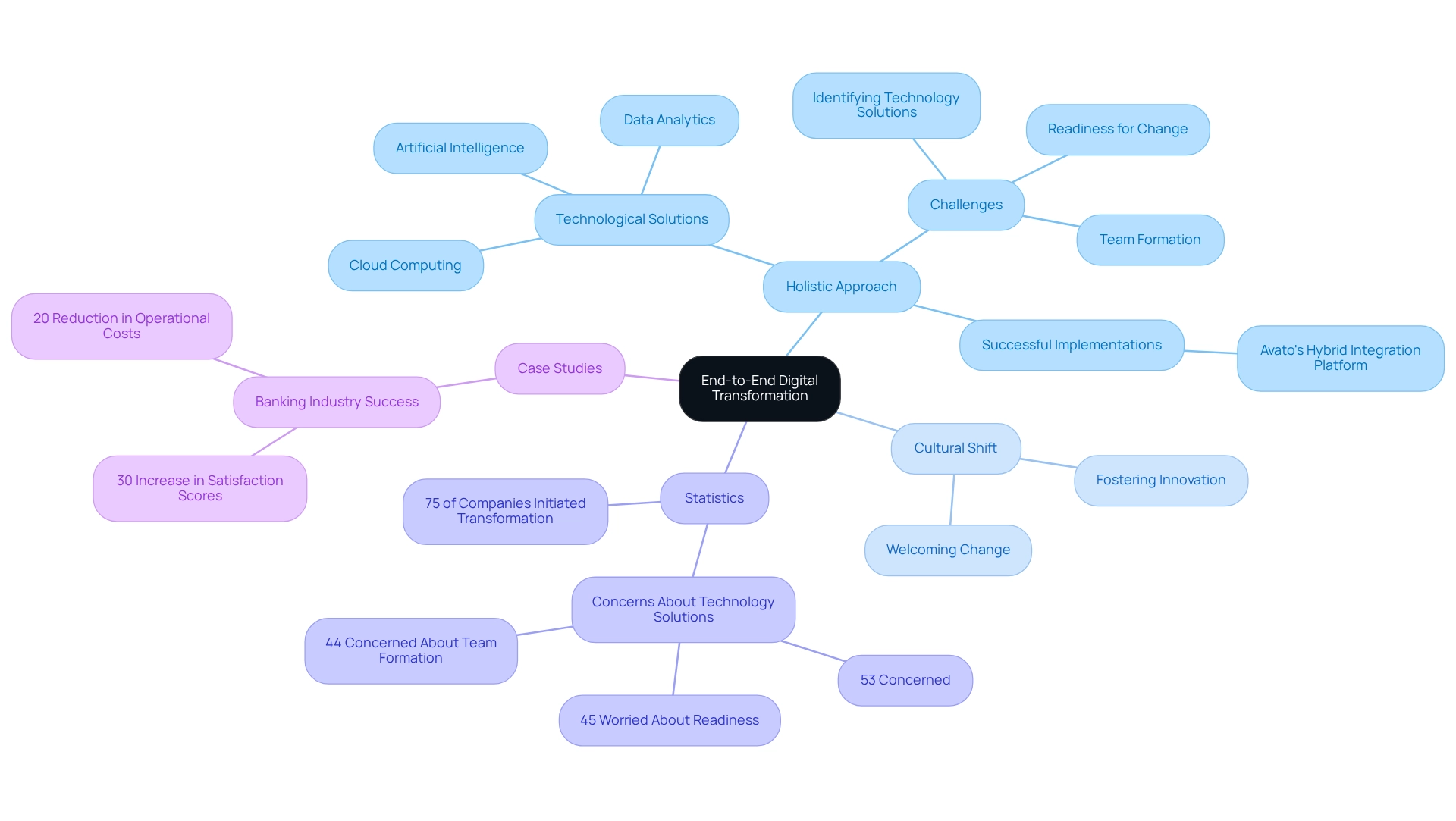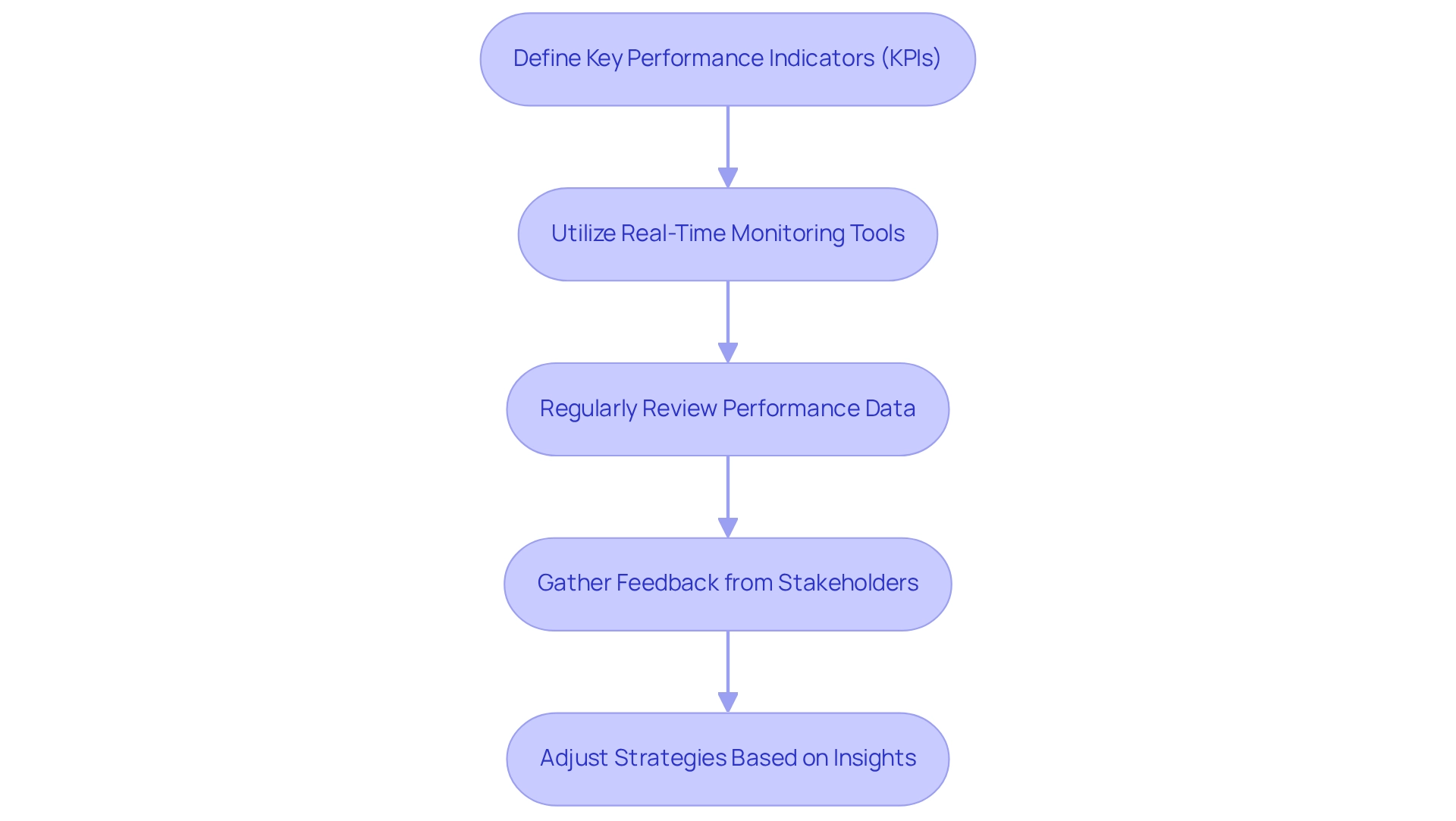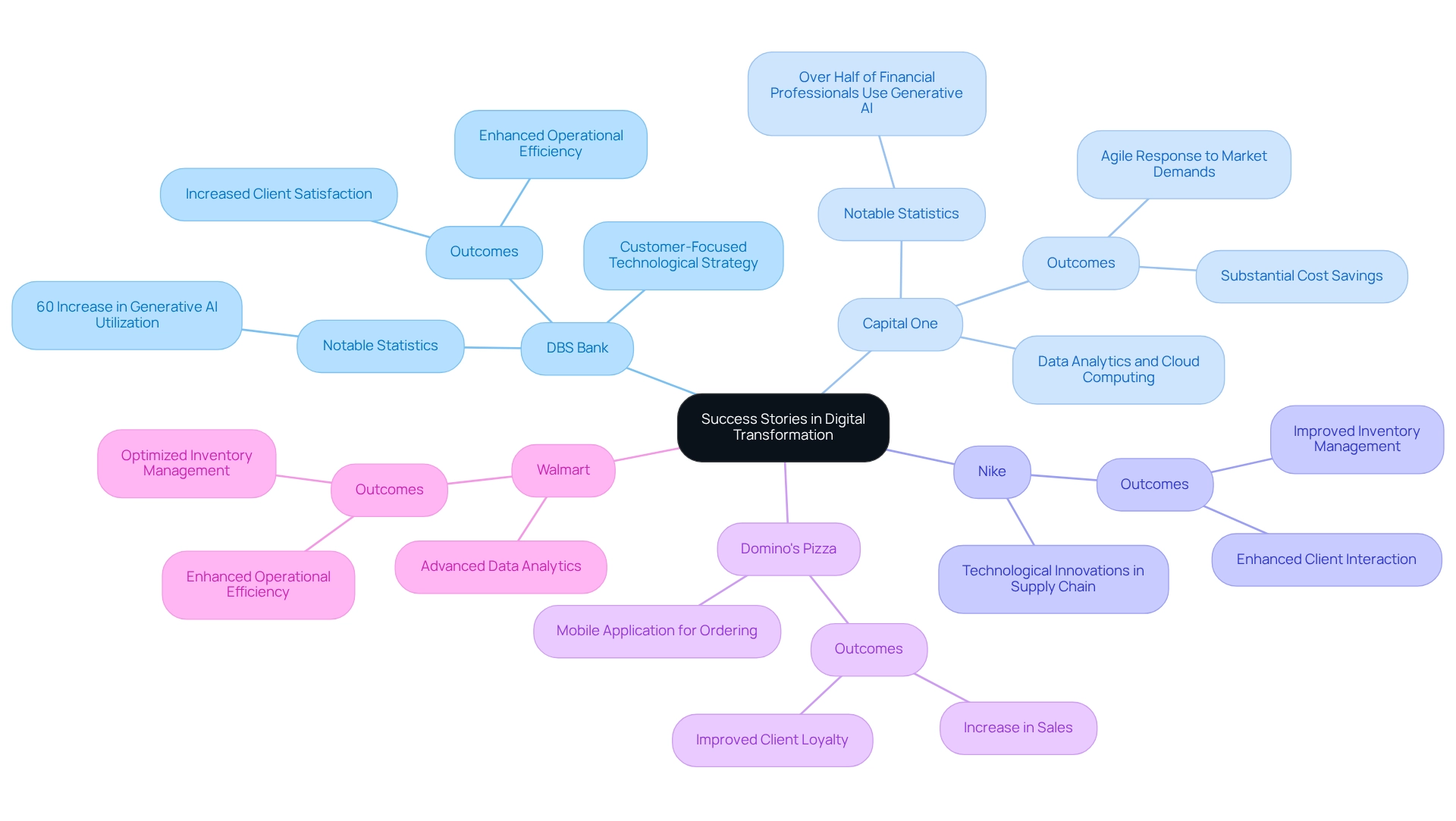Overview
To achieve comprehensive digital transformation, organizations must integrate digital technologies across all business facets. This integration is not merely a technical upgrade; it requires fostering a culture that embraces change and innovation. How can organizations navigate this complex landscape? The answer lies in a holistic approach, bolstered by unwavering leadership commitment, a client-focused strategy, and agile methodologies. Such a strategy is essential for enhancing operational efficiency and customer satisfaction in a rapidly evolving market. By prioritizing these elements, businesses can not only adapt but thrive amidst change.
Introduction
In the rapidly evolving digital landscape, organizations are embarking on transformative journeys that redefine their operational frameworks and customer interactions. But what does it really mean to undergo end-to-end digital transformation? It goes beyond simply upgrading technology; it requires a comprehensive overhaul of business models, processes, and cultural mindsets. As companies strive to create seamless experiences for both customers and employees, they encounter a myriad of challenges—from integrating legacy systems to fostering a culture of innovation.
This article delves into the essential components of successful digital transformation, explores the integration of advanced technologies, and highlights real-world case studies that illustrate the profound impact of these initiatives on customer satisfaction and operational efficiency. By understanding these dynamics, organizations can better navigate their digital transformation journeys and position themselves for sustainable growth in an increasingly competitive marketplace.
Understanding End-to-End Digital Transformation
End-to-end digital transformation encompasses the thorough integration of digital technologies across every facet of an organization. This journey transcends mere technological upgrades; it necessitates a fundamental rethinking of business models, processes, and client interactions. The ultimate aim is to achieve end-to-end digital transformation by developing a seamless experience for both clients and employees, ensuring that every touchpoint is optimized for maximum efficiency and effectiveness.
Key components of this change encompass:
- Holistic Approach: A successful strategy for technological evolution addresses all areas of the business, from operations to customer service, ensuring that every department aligns with the overall vision. Leveraging advanced technologies such as artificial intelligence, cloud computing, and data analytics is crucial for enhancing operational capabilities and driving innovation through end-to-end digital transformation. Avato’s hybrid connectivity platform exemplifies this by streamlining the unification of disparate systems, enabling organizations to unlock isolated assets and create significant business value. Key characteristics of Avato’s platform include real-time data synchronization, seamless API management, and strong security protocols, all aimed at enabling smooth integration processes.
- Cultural Shift: Fostering a culture that welcomes change and innovation is vital for creating an environment where technological evolution can flourish.
Current statistics show that approximately 75% of companies have already initiated their technological advancement journeys, highlighting a rising acknowledgment of its crucial role in sustaining competitiveness and relevance in today’s market. However, challenges persist; 53% of organizations express concerns about identifying the appropriate technology solutions for workplace change, while 45% worry about their readiness to adopt these alterations. Additionally, 44% are concerned about forming a dedicated team to lead transformation initiatives.
The effect of end-to-end digital transformation on user experience is substantial. Organizations that effectively execute these strategies report notable enhancements in satisfaction and engagement. Successful case studies in the banking industry emphasize how Avato’s hybrid connection platform has resulted in improved operational capabilities and lowered expenses, ultimately benefiting both the organization and its clients. One notable example includes a leading bank that utilized Avato’s platform to enhance its service operations, resulting in a 30% increase in satisfaction scores and a 20% reduction in operational costs.
Furthermore, insights from NVIDIA’s 2025 survey reveal that AI is revolutionizing financial services, driving revenue growth and operational efficiency through advanced integration solutions. By utilizing generative AI, organizations can further improve client engagement and optimize operations.
By comprehending these elements and the present context of technological evolution, organizations can navigate challenges more effectively and capitalize on the opportunities that emerge in this dynamic setting. To investigate how Avato can assist your online evolution journey, reach out to us today for a customized consultation.

Key Components of a Successful Digital Transformation
A successful online shift relies on several crucial elements that collectively drive organizational change and enhance customer interaction.
- Leadership Commitment: Effective technological change demands unwavering dedication from leadership. Strong leaders not only align the organization’s vision with technological objectives but also cultivate a culture that embraces change.
Research indicates that organizations with committed leadership are significantly more likely to achieve their technological change goals, as they prioritize essential resources and strategic guidance. Moreover, the deployment of high-caliber talent is vital for successful end-to-end digital transformation; however, only one in four organizations effectively secures the necessary skills and expertise. Avato’s expert integration services can assist organizations in augmenting their internal teams with skilled professionals, ensuring they possess the right talent to navigate this journey.
- Client-Focused Approach: Understanding client needs and preferences is essential for developing services and products that resonate with the target audience. In 2025, adopting a customer-centric approach is not merely beneficial but imperative, as 24% of companies are still strategizing their digital transformation efforts. By prioritizing client insights, organizations can tailor their offerings to enhance satisfaction and loyalty.
Avato’s hybrid unification platform supports this by enabling seamless data flow and connection, allowing businesses to better comprehend and respond to client needs.
- Agile Methodologies: The adoption of agile practices empowers organizations to respond swiftly to market changes and continuously refine their processes. This flexibility is crucial in today’s fast-paced environment, enabling teams to iterate quickly and deliver value more effectively.
Avato’s services, including project management and software development, are designed to accelerate end-to-end digital transformation through secure and efficient system integration, facilitating agile responses to evolving market demands.
- Data-Driven Decision Making: Leveraging data analytics is vital for informed decision-making. Organizations that utilize data effectively can enhance operational efficiency and increase client satisfaction.
The ability to analyze customer behavior and market trends empowers businesses to make proactive adjustments, ensuring they remain competitive. Avato’s unification solutions provide the essential infrastructure to enable robust data analytics capabilities.
- Technology Infrastructure: Investing in a strong technology framework that facilitates connection and scalability is essential for lasting success.
A well-designed technology stack not only ensures seamless data flow but also enables organizations to adapt to evolving demands without significant disruptions. Avato’s hybrid integration platform, built on Red Hat’s JBoss Middleware, exemplifies this by offering a scalable solution that integrates various systems efficiently. The application of Red Hat’s technology enhances the platform’s features, providing users with a reliable and high-performing environment for their online evolution projects.
By focusing on these essential elements, organizations can establish a solid foundation for their end-to-end digital transformation efforts. As highlighted by industry leaders, the commitment to a customer-focused strategy is increasingly recognized as a fundamental component of successful online evolution. For instance, Josh Howarth notes that the COVID-19 pandemic has accelerated technological advancement efforts by an average of six years, underscoring the necessity for companies to adapt and innovate.
Furthermore, the limitations and future research directions in leadership studies suggest that further investigation of variables influencing success is crucial. These insights reinforce the significance of leadership dedication and a customer-centric strategy in navigating the complexities of technological change.
Integrating Legacy Systems for Seamless Transformation
Incorporating legacy systems presents considerable difficulties during digital modernization; however, it is crucial for achieving seamless connectivity and operational effectiveness. To facilitate effective incorporation, consider the following key steps:
- Assessment of Current Systems: Begin by thoroughly evaluating existing legacy systems to understand their capabilities and limitations. This assessment is vital, as 44% of organizations express concerns about the need for dedicated teams to drive transformation efforts, underscoring the importance of a strategic approach.
- Define Connection Goals: Clearly establish objectives for the unification process. Goals may include enhancing data flow, improving operational efficiency, or elevating customer experiences. Establishing specific goals aids in directing the incorporation strategy and ensures alignment with broader business objectives.
- Choose the Right Connection Tools: Select contemporary connection platforms that enable the linking of legacy systems with new applications. These tools should guarantee compatibility and uphold data integrity, which is crucial for reducing risks related to cyber threats—recognized by 24% of IT decision-makers as a significant obstacle to digital advancement. Additionally, the average cyberattack cost a business $9.48 million in 2023, highlighting the financial risks involved. Utilizing XSLT can greatly enhance this process by simplifying XML data conversion and minimizing programming errors through its declarative characteristics and connection with schemas, resulting in substantial cost savings. Employing the right technology and tools, as outlined in the user manual, can further aid in accurately illustrating the current and ideal states of integration.
- Implement Incremental Changes: Instead of attempting a complete overhaul of systems at once, adopt a gradual approach to implementing changes. This strategy minimizes disruption and allows for modifications based on immediate feedback, ensuring that the incorporation process remains manageable and efficient. Organizations should avoid rushing legacy IT transformation and focus on upgrades that deliver significant benefits, such as migrating to a cloud-hosted email server for quick returns.
- Continuous Monitoring and Optimization: Regularly observe the incorporation process and make necessary adjustments to enhance performance. Ongoing improvement is essential, particularly considering the skills gaps affecting 22% of organizations, which can obstruct the successful completion of collaboration projects. Utilizing analytics and monitoring tools can help optimize system performance, ensuring that they remain efficient and responsive to evolving business needs. Insights from the FAQs can also provide direction on common challenges and solutions associated with incorporation projects.
By following these steps, organizations can effectively assimilate legacy systems into their technological advancement strategies, paving the way for a smoother transition and enhanced operational capabilities. Successful examples of legacy system integration demonstrate that with the right approach, businesses can overcome challenges and achieve significant benefits, such as reduced costs and improved service delivery. It is crucial for stakeholders to engage throughout this process to ensure alignment and success, as emphasized in the user manual.
Monitoring and Measuring Success in Digital Transformation
To ensure the success of digital transformation initiatives, organizations must implement robust monitoring and measurement strategies that encompass several critical elements:
- Define Key Performance Indicators (KPIs): Establish specific metrics that align with change objectives. These may include customer satisfaction scores, operational efficiency rates, and revenue growth figures. A precise definition of KPIs is vital, as 22% of executives mention economic uncertainty as a major obstacle to executing technological changes, making it essential to have measurable objectives.
- Utilize Real-Time Monitoring Tools: Deploy tools that offer real-time insights into system performance and user engagement. This capability allows organizations to make swift adjustments, ensuring that they can respond to issues as they arise. Statistics indicate that organizations leveraging real-time monitoring tools experience enhanced operational capabilities, which is vital in today’s fast-paced environment. With Avato’s hybrid integration platform, businesses can achieve seamless data flow, enhancing their ability to monitor and respond effectively.
- Regularly Review Performance Data: Conduct periodic assessments of performance data to evaluate progress against established KPIs. This practice not only helps in tracking success but also in identifying areas that require improvement. Regular assessments can reduce the obstacles to successful digital change, such as competing priorities and skill gaps, which are frequently reported by organizations. An integrated data platform simplifies this process by providing a unified view of performance metrics across systems.
- Gather Feedback from Stakeholders: Collect insights from employees and customers to evaluate the effectiveness of new processes and technologies. Involving stakeholders in this way promotes a culture of ongoing enhancement and guarantees that the change aligns with user needs and expectations. Avato’s platform facilitates this engagement by ensuring that data is accessible and actionable, bridging the gap between legacy systems and modern expectations.
- Adjust Strategies Based on Insights: Utilize the data and feedback gathered to refine strategies, ensuring that the change remains aligned with organizational goals. This iterative method is essential, particularly as 26% of senior executives recognize high expenses as a significant barrier to technological advancement. By leveraging Avato’s integration capabilities, organizations can reduce complexity and enhance their agility in adapting to change.
Furthermore, organizations should contemplate the 4 Ps of technological change: process, people, platforms, and performance. By concentrating on these components, businesses can develop a comprehensive strategy for their improvement initiatives.
By concentrating on these monitoring and measurement practices, organizations can effectively assess the success of their end-to-end digital transformation efforts, ultimately leading to enhanced outcomes and a stronger competitive position in their respective sectors. As mentioned by Gustavo Estrada, a client, ‘Avato has streamlined intricate projects and provided outcomes within preferred timelines and budget limits,’ emphasizing the significance of efficient oversight in attaining successful changes.

Overcoming Challenges in Digital Transformation
Organizations frequently face a myriad of challenges on their digital transformation journeys. To effectively navigate these obstacles, consider the following strategies, particularly with the support of Avato’s pioneering hybrid integration solutions:
- Resistance to Change: Cultivating a culture that embraces change is paramount. How can you engage your staff in the change process? Offering comprehensive training can facilitate a smoother transition. Research indicates that a substantial portion of employees resist change due to fear of the unknown, making it vital to communicate the benefits clearly. Notably, 81% of business leaders view investment in technological change as a crucial or essential component for achieving success in their organizations.
- Siloed Departments: Collaboration among departments is essential for aligning technological initiatives with overarching business objectives. Did you know that organizations with strong interdepartmental cooperation are five times more likely to achieve their transformation goals? Avato’s hybrid unification platform fosters this collaboration by unlocking isolated assets, enabling knowledge sharing and innovation across teams, ultimately driving business value creation.
- Insufficient Budget: Focus on digital initiatives that promise the highest return on investment. How do you prioritize projects based on their potential impact? This prioritization can help secure additional funding. In times of economic uncertainty, as noted by 22% of business leaders, demonstrating the value of these initiatives becomes increasingly critical. Avato’s solutions can assist in identifying and leveraging high-impact collaboration opportunities that enhance business value.
- Lack of Expertise: Address skills shortages by investing in training programs that upskill existing employees. Have you considered hiring external experts who can provide guidance and insights based on industry best practices? This approach not only enhances internal capabilities but also fosters a culture of continuous learning. The case study titled “Barriers to Transformation Progress” underscores that IT decision-makers identified skills shortages as a primary obstacle hindering advancement in transformation initiatives. Avato’s team of integration experts is dedicated to delivering results and can provide the necessary support to bridge these gaps.
- Data Security Concerns: As organizations transition to online platforms, robust cybersecurity measures are essential to protect sensitive data. With 71% of customers more likely to trust a company that transparently explains its data usage, how can you enhance customer confidence? Avato’s hybrid integration platform is designed with security as a priority, addressing cyber threats and ensuring adherence to ESG objectives, which are significant challenges organizations must confront to advance their technological efforts effectively.
By proactively addressing these challenges with Avato’s innovative solutions, organizations can significantly improve their prospects for successful technological change, ensuring they remain competitive in an increasingly digital landscape. The name ‘Avato,’ derived from the Hungarian word for ‘of dedication,’ reflects the company’s commitment to architecting the technology foundation necessary to deliver rich, connected customer experiences.
Case Studies: Success Stories in Digital Transformation
Studying successful case studies provides invaluable insights for organizations embarking on their technological change journey.
DBS Bank: By adopting a customer-focused technological strategy, DBS Bank transitioned from a conventional banking model to a technology leader. This transformation not only boosted client satisfaction but also significantly enhanced operational efficiency, demonstrating the profound impact of prioritizing a technological culture in change initiatives.
As highlighted by the Boston Consulting Group, prioritizing culture in digital transformation yields results five times more remarkable than other approaches. Furthermore, the integration of generative AI has empowered DBS Bank to develop advanced chatbots and virtual assistants, further enriching client interactions. Notably, there has been a 60% increase in the utilization of generative AI for client experience, underscoring its critical role in contemporary banking.
Capital One: This financial institution harnessed the power of data analytics and cloud computing to elevate client experiences and optimize operations. The outcome was substantial cost savings and a more agile response to market demands, illustrating the effectiveness of leveraging technology in banking. Additionally, with over half of financial professionals now employing generative AI for document processing and report generation, Capital One exemplifies how embracing these technologies can enhance productivity.
However, 22% of senior executives regard economic uncertainty as a significant barrier to implementing technological changes, emphasizing the urgency of such initiatives, particularly in the wake of the pandemic.
Nike: By integrating technological innovations into its supply chain, Nike improved inventory management and enhanced client interaction through personalized marketing strategies. This case illustrates how retail can derive advantages from digital change by aligning operations with client expectations.
Domino’s Pizza: The company revolutionized its ordering system with an easy-to-use mobile application, resulting in a notable increase in sales and client loyalty. This change highlights the importance of convenience and accessibility in enhancing client experiences.
Walmart: By adopting advanced data analytics, Walmart optimized its inventory management and improved service, leading to enhanced operational efficiency.
These cases underscore the various strategies organizations can employ to achieve successful online change, emphasizing the necessity of aligning technology with customer needs and operational goals. As the urgency for digital transformation accelerates across industries, particularly due to the pandemic, understanding these success stories can guide banking IT managers in navigating their own transformation journeys effectively. Moreover, Avato’s hybrid unification platform plays a pivotal role in addressing the challenges of connecting isolated legacy systems and fragmented data.
By simplifying complex collaboration projects, Avato enhances operational capabilities for organizations in regulated environments. Specifically, Avato’s platform facilitates the integration of generative AI, enabling financial institutions to reduce costs, deliver products more swiftly, and enhance client satisfaction.

Future Trends in Digital Transformation
As end-to-end digital transformation continues to evolve, several key trends are anticipated to shape its future landscape, particularly in the banking sector.
- Increased Adoption of AI: Organizations are set to increasingly leverage artificial intelligence to enhance decision-making processes, automate routine tasks, and significantly improve customer experiences. The year 2025 is anticipated to be crucial for AI advancement, with experts observing that its incorporation will transform various sectors while presenting complex challenges.
Avato’s hybrid integration platform can facilitate end-to-end digital transformation by providing the necessary infrastructure to support AI-driven solutions.
- Focus on Data Privacy: With rising concerns surrounding data security, organizations will prioritize the establishment of robust data governance frameworks. A recent study suggests that 71% of clients are more inclined to trust a company with their personal data if its usage is clearly explained.
This statistic highlights the significance of transparency in data management, which is essential for establishing client trust. Avato’s services include comprehensive data management strategies that ensure compliance and support end-to-end digital transformation, thereby enhancing customer confidence.
- Integration of IoT: The Internet of Things (IoT) will play a crucial role in enhancing operational efficiency and enabling real-time data collection.
By connecting devices and systems, organizations can gain valuable insights that drive informed decision-making and streamline operations. Avato’s hybrid integration platform supports seamless IoT integration, which is essential for banks pursuing end-to-end digital transformation to harness the power of connected devices effectively.
- Emphasis on Sustainability: Digital transformation initiatives will increasingly align with sustainability goals, focusing on reducing environmental impact.
Companies are recognizing that integrating sustainable practices not only benefits the planet but also enhances their brand reputation and customer loyalty. Avato’s solutions are designed to facilitate end-to-end digital transformation by promoting sustainable practices through efficient resource management and reduced operational footprints.
- Remote Work Technologies: The rise of remote work has accelerated the adoption of digital collaboration tools, fundamentally reshaping workplace dynamics.
Avato’s expert integration services support businesses in achieving end-to-end digital transformation by implementing secure and efficient remote work solutions, ensuring that teams remain productive and connected regardless of their location.
- Collaboration with Managed Service Providers: Avato partners with managed service providers worldwide, improving its capacity to carry out data modification projects efficiently. This collaboration enables Avato to enhance internal teams as required, ensuring that organizations have the appropriate expertise and resources to successfully navigate their end-to-end digital transformation journeys.
- Enterprise Architecture and Project Management: Avato’s services encompass enterprise architecture and project management, which are essential for aligning technology initiatives with business goals. By leveraging these methodologies, Avato helps organizations streamline their processes and achieve their end-to-end digital transformation objectives more efficiently.
Conclusion
In today’s fiercely competitive landscape, end-to-end digital transformation is not just beneficial; it is essential for organizations aiming for success. This transformation transcends the mere adoption of new technologies; it demands a thorough reevaluation of business models, processes, and organizational culture. By emphasizing leadership commitment, a customer-centric focus, and agile practices, businesses can craft seamless experiences that significantly enhance customer satisfaction and operational effectiveness.
The integration of cutting-edge technologies, such as AI and data analytics, is pivotal for fostering innovation and achieving sustainable growth. Take, for instance, the success stories of DBS Bank and Capital One; they exemplify how effective digital transformation can elevate customer experiences while yielding substantial cost savings. These cases underscore the critical need for aligning technology with customer requirements.
However, organizations often encounter obstacles, including resistance to change and data security concerns. Thus, it becomes imperative to implement strategies that promote collaboration and continuous improvement. Establishing clear KPIs and employing real-time monitoring can empower businesses to track their progress and adapt as necessary.
As the landscape of digital transformation continues to evolve, trends such as increased AI adoption, heightened data privacy, and a commitment to sustainability will play a significant role in shaping the future. Organizations that proactively embrace these trends and harness innovative integration solutions will be better positioned to navigate the complexities of their transformation journeys. Ultimately, by embracing digital transformation, businesses not only equip themselves to tackle current challenges but also lay the groundwork for a resilient and prosperous future.

